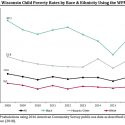War on Poverty anniversary leads to release of national poverty report card
Income inequality is on the rise, according to a national report card co-authored by Timothy Smeeding, director of the Institute for Research on Poverty at the University of Wisconsin–Madison.

Timothy Smeeding
“It looks like inequality is resuming its relentless upward trend after a brief respite during the recession and that we are headed for yet higher inequality in income and wealth in the years to come,” Smeeding says.
Smeeding and Jeffrey Thompson, an economist with the Federal Reserve, examined trends before, during and after the Great Recession of 2008 to 2009. They found that the recession had a mixed effect on inequality, with some measures increasing and others flattening.
In the recovery period since mid-2009, however, all of the measures show income inequality is rising. By 2012, the share of income going to the top one percent had rebounded close to the high levels measured before the recession.
Their findings are part of the first national Report Card on Poverty and Inequality published by the Stanford Center on Poverty. The report card coincides with the 50th anniversary of the War on Poverty, President Lyndon B. Johnson’s initiative that he announced during his 1964 State of the Union Address.
“Our aim is not only to relieve the symptom of poverty, but to cure it and, above all, to prevent it,” Johnson said.
The Report Card on Poverty and Inequality was authored by a group of leading social scientists who convened Jan. 13 at Stanford University to assess the current state of poverty and inequality in the country, dividing their evaluations into seven key categories: education, health, labor markets, poverty, the safety net, income inequality and wealth inequality. Complete findings can be found here.
Smeeding and Thompson also found that taxable income of the top one percent grew 31 percent from 2009 to 2012, while for the rest of the population it grew by only 0.4 percent. The highest-income group captured 95 percent of all income growth in the first three years of the post-recession recovery due to strong rebounding of profits and equities that were not accompanied by improvements in wages.
“It looks like inequality is resuming its relentless upward trend after a brief respite during the recession and that we are headed for yet higher inequality in income and wealth in the years to come.”
Timothy Smeeding
The War on Poverty led to the establishment of the IRP at UW–Madison, the nation’s original center for study of poverty. IRP is a nonpartisan, academic center designed to inform evidence-based policymaking and continues to be recognized as one of the nation’s leaders in multidisciplinary poverty research.
IRP was established as part of the effort the architects of the War on Poverty in the 1960s determined that the new programs and policies then being developed would be studied and evaluated to determine their effectiveness. Having a center removed from the political arena in Washington, D.C., made sense.
Establishing the poverty research center at the UW–Madison also made sense because of its long tradition of applied social science research and because several of its faculty members had served on the staff of the president’s Council of Economic Advisers when the antipoverty strategy was being planned.
One of those planners, the late Robert Lampman, a UW–Madison economics professor and IRP’s first interim director, is mentioned in the national report card on poverty. Written by Sheldon Danziger of the Russell Sage Foundation( and former IRP director) and Christopher Wimer of Columbia University, the brief notes that Lampman was among the observers who drew attention to the fact that the rapid economic growth after World War II was leaving many families behind.
“The analysis of recent changes in poverty by Danziger and Wimer suggests that when properly accounted for, in-kind benefits like food assistance (SNAP), housing subsidies and refundable tax credits have improved the lot of the poor in recent years and have fought back against the unemployment and low wages since the Great Recession,” says Smeeding, of the La Follette School of Public Affairs. “The long-term solution to poverty is a steady job that pays high enough wages to move a family over the poverty line. Until the labor market recovers, benefit programs are necessary to supplement low wages for otherwise desperate families.”
– Deborah Johnson



